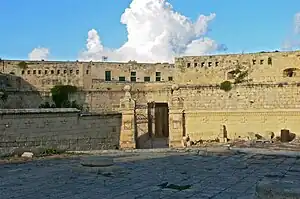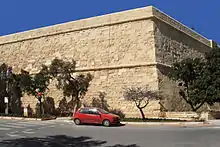Rising of the Priests
The Rising of the Priests (Maltese: Ir-Rewwixta tal-Qassisin), also known as the Maltese Rebellion of 1775 and the September 1775 Rebellion,[1] was an uprising led by Maltese clergy against the Order of Saint John, who had sovereignty over Malta. The uprising took place on 8 September 1775, but was suppressed by the Order within a few hours. The rebels were then captured and some were executed, exiled or imprisoned.
| Rising of the Priests | |||
|---|---|---|---|
| Part of the decline of the Order of Saint John | |||
 Entrance to Fort Saint Elmo | |||
| Date | 8 September 1775 | ||
| Location | 35°54′7″N 14°31′7″E | ||
| Caused by |
| ||
| Methods |
| ||
| Resulted in |
| ||
| Parties | |||
| |||
| Lead figures | |||
Gaetano Mannarino | |||
| Number | |||
| |||
| Casualties and losses | |||
| |||
Background
The causes of the revolt can be traced back to 1773, when Francisco Ximénez de Tejada was elected Grand Master upon the death of Manuel Pinto da Fonseca. Ximénez found a depleted treasury, so he introduced austerity measures, including reducing spending and increasing the price of corn. These made him unpopular, both with the clergy and the common people.[2]
Ximénez issued an edict banning the hunting of hares (Maltese: Fenek tax-xiber) by the common people,[3] in order to reserve the hunt for the elite.[4] The ban was opposed by Bishop Giovanni Carmine Pellerano and the clergy. Other events also created tension between the clergy and the Order.[5]
Revolt
Due to the tension between the Order and the clergy, and the negative public opinion of Ximénez, some priests led by Don Gaetano Mannarino began to plot against the Order. They chose 8 September as the day of the rebellion, when the Order's ships were at sea with the Spanish Navy and Valletta was not well defended. A total of 28 clergymen and a larger number of laymen were involved in the planning of the uprising.[6]

On the day of the revolt, only eighteen of the 28 clergymen showed up. Despite this, Mannarino still decided to carry on with the uprising. A group of thirteen men took over Fort Saint Elmo on the northern tip of Valletta, while the rest of the rebels captured Saint James Cavalier on the opposite end of the city. In both cases, the Order's flag was lowered and the banner of St. Paul was hoisted instead.[6]
When the uprising broke out, Ximénez summoned the Council of State to see how to suppress the revolt. The Council sent the Vicar General to find out the demands of the rebels, who agreed to negotiate. However, at one point they threatened to blow up St. Elmo's gunpowder magazine, which would cause severe damage to the fort and the city's fortifications.[note 1] Due to this, the Order decided to recapture the occupied fortifications by force. St. Elmo was captured after a brief exchange of fire, while St. James surrendered soon afterwards. Of the 18 priests involved, only 12 remained at their posts to the end.[7]
Aftermath
After surrendering, the rebels were imprisoned in Fort Saint Elmo. The first trials were held in October 1775 and continued after the death of Ximénez on 4 November. Three of the rebels were executed, while others were imprisoned, exiled or acquitted.[8]
The ringleader Mannarino was one of those sentenced to life imprisonment. He was eventually released along with other political prisoners, after over twenty years imprisonment, during the French occupation of Malta in 1798. He died in 1814, at the age of 81.[9]
Notes
- Blowing up the magazine would have been devastating. In 1806, when the magazine in Birgu exploded, around 200 people were killed and part of the fortifications was destroyed. During the Froberg mutiny in 1807, Fort Ricasoli's magazine was blown up by mutineers, killing three people and destroying a bastion.
References
- "The Magna Curia Castellania" (PDF). Melitensia. The Malta Study Center: 5. Spring 2012. Archived from the original (PDF) on 2 April 2016.
- Fava, Peter (1978). "A Reign of Austerity: Economic Difficulties During the Rule of Grand Master Ximénez (1773–1775)" (PDF). Storja: 42–59.
- Portelli, Paul (4 April 2012). "How the wild rabbit was tamed". Times of Malta. Archived from the original on 12 August 2016.
- "Malta's hunting bans have been contested for centuries, research shows". Times of Malta. 2018-11-17. Retrieved 2020-09-07.
- Bellizzi, W. F. (2005). "The Rising of the Priests". Malta Historical Society. Archived from the original on 21 April 2014.
- Borg-Muscat, David (1933). "Reassessing the September 1775 Rebellion: A Case of Lay Participation or a 'Rising of the Priests'" (PDF). Melita Historica. 3 (2): 239–252. Archived from the original (PDF) on 16 April 2016.
- Sciberras, Sandro. "Maltese History – E. The Decline of the Order of St John In the 18th Century" (PDF). St Benedict College. Archived from the original (PDF) on 30 April 2015.
- Borg Muscat, David (2005). "Reassessing the September 1775 Rebellion: a Case of Lay Participation or a 'Rising of the Priests'?". Malta Historical Society. Archived from the original on 21 April 2014.
- Schiavone, Michael J. (2009). Dictionary of Maltese Biographies Vol. II G-Z. Pietà, Malta: Pubblikazzjonijiet Indipendenza. pp. 1100–1102. ISBN 9789993291329.

